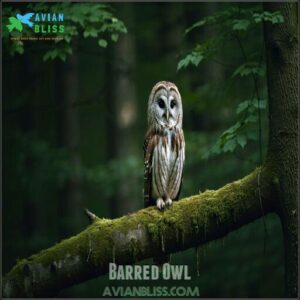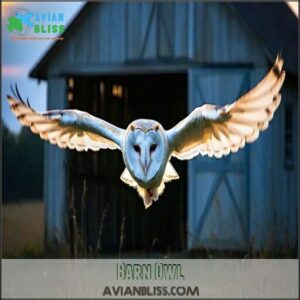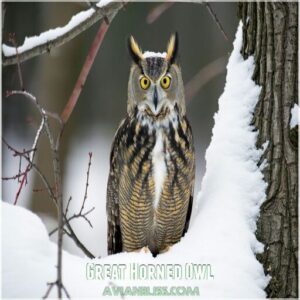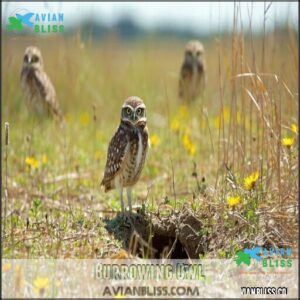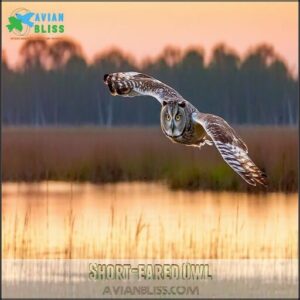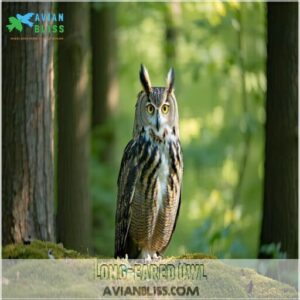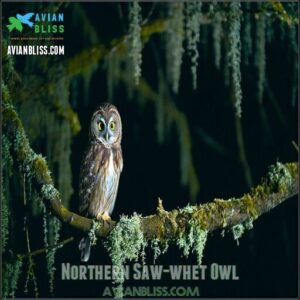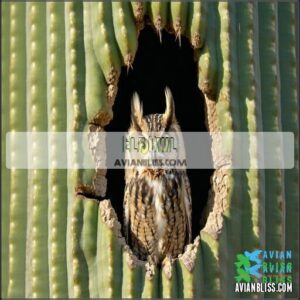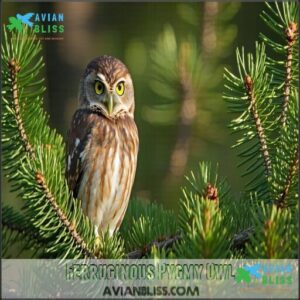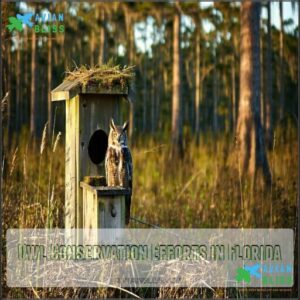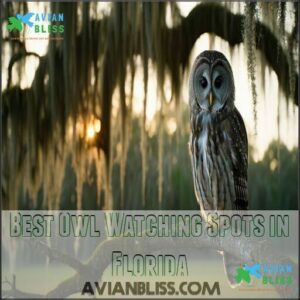This site is supported by our readers. We may earn a commission, at no cost to you, if you purchase through links.
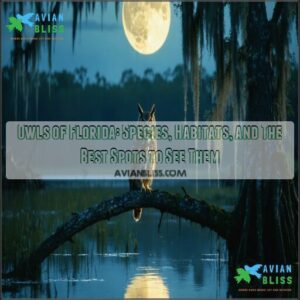
You’ll also find the ghostly white Barn Owl gliding through open fields and the Barred Owl haunting swamps with its distinctive “who cooks for you” call.
These nocturnal hunters adapt to habitats ranging from dense forests to suburban neighborhoods, making them surprisingly accessible.
Whether you’re tracking their soft wingbeats or deciphering their hoots, Florida’s owls offer a glimpse into nature’s quieter side.
Curious about their best hangouts? Stick around for expert tips.
Table Of Contents
- Common Owl Species in Florida
- Rare and Uncommon Owls of Florida
- Florida Owl Habitats and Behavior
- Identifying Florida Owls: Key Features and Calls
- Owl Conservation Efforts in Florida
- Best Owl Watching Spots in Florida
- Frequently Asked Questions (FAQs)
- Are there owls in Orlando?
- Where do burrowing owls live in Florida?
- How many owls are in Florida?
- Do owls live in Florida?
- Are there Barn owls in Florida?
- What is the tiniest owl in Florida?
- What is the most common owl in Florida?
- Is it good to have an owl in your yard?
- What is the largest owl in Florida?
- How many types of owls are there in Florida?
- Conclusion
Common Owl Species in Florida
Florida hosts a variety of owl species, each with unique features that make them both fascinating and important to local ecosystems.
Owls in Florida captivate with their mysterious calls and vital role in balancing diverse ecosystems across forests, swamps, and urban spaces.
From the tiny Eastern Screech Owl to the majestic Great Horned Owl, you’ll find these remarkable birds in habitats ranging from forests to open fields.
Eastern Screech Owl
On quiet Florida nights, the Eastern Screech Owl might greet you with its whinnying vocalizations. This tiny marvel, known for its stunning color morphs in gray and rusty-red, blends perfectly into tree bark, showing off expert mimicry behavior.
Found in urban habitats, forests, and parks, this owl species thrives on a varied diet of insects, small mammals, and snakes.
Want them as neighbors? Try these tips:
- Install nest boxes on mature trees.
- Leave brush piles to attract insects.
- Provide fresh water nearby.
- Keep outdoor spaces peaceful at dusk.
**Florida owls truly bring magic to twilight.
Barred Owl
The Barred Owl, with its famous “Who cooks for you?” call, thrives in Florida’s dense forests.
This owl species prefers tree cavities for nesting, using their streaked feathers to disappear into the bark backdrop. You’ll find them hunting small mammals at night, though they’re most vocal at dusk and dawn.
Like other owls, they also regurgitate indigestible pellets containing bones and fur.
| Feature | Details |
|---|---|
| Diet | Small mammals, amphibians |
| Nesting Habits | Tree cavities |
| Call Variations | Whistling, hooting tones |
| Habitat | Dense forests, swamp areas |
| Regional Range | Central and Northern Florida |
Barn Owl
Barn Owls, often called "ghostly hunters," are masters of silent flight, effortlessly gliding through Florida’s night skies.
Their unmistakable heart-shaped face isn’t just for looks—it enhances their incredible hearing, letting them pinpoint prey like rodents, even in total darkness.
Farmers love them for natural rodent control, as their owl diet consists mainly of mice and rats.
- Fun fact: Unlike other owls, Barn Owls don’t hoot. Instead, they emit eerie screeches that might remind you of a haunting soundtrack!
These adaptable birds nest in barns, hollow trees, or abandoned buildings, making them key players in owl conservation efforts, especially amid growing habitat loss concerns.
Great Horned Owl
The great horned owl, a magnificent owl species in Florida, stands out with its iconic feather tufts and piercing yellow eyes.
Known for its habitat range, it thrives in dense woodlands, swamps, and urban parks.
These expert hunters play a key role in Florida wildlife, even aiding in python control within the Everglades.
Their deep “hoo-h’HOO-hoo” calls echo during winter breeding, as they fiercely guard their territory.
With stealthy flight and a varied owl diet, they’re masters of survival.
Burrowing Owl
The Burrowing Owl, one of the most charming owl species Florida offers, thrives in Cape Coral’s open spaces and FAU Relocation efforts aim to protect them during construction.
These quirky, pint-sized owls defy owl conventions by hunting during the day and sprinting after prey like tiny athletes. Their burrowing diet, made up of insects and small rodents, helps with natural pest control.
Nesting habits involve underground burrows, but habitat destruction poses a threat. Community-driven conservation programs work tirelessly to safeguard these fascinating icons of Florida wildlife, and their efforts are crucial for the owls’ survival, making them a key part of natural pest control.
Rare and Uncommon Owls of Florida
When you’re looking for Florida’s rarest owls, you’ll notice species that are truly remarkable yet seldom seen.
From the tiny Northern Saw-whet Owl to the impressive Snowy Owl, these elusive birds often require patience and a bit of luck to spot.
Short-eared Owl
The Short-eared Owl is a rare winter visitor among Florida birds, enchanting wildlife enthusiasts with its graceful, moth-like flight.
Known for its global distribution and migration patterns, this owl prefers open grasslands and marshes across Florida.
Silent and precise, it hunts rodents by gliding low over ground vegetation.
Though listed as "Least Concern," habitat loss and other threats stress its populations.
Catching one during your Florida birding adventures feels like spotting nature’s hidden treasure!
Long-eared Owl
The Long-eared Owl, a rarity in Florida, quietly graces the state’s wooded areas during the winter months.
With its slim build and signature long ear tufts, this nocturnal predator blends perfectly into its surroundings.
You’ll often spot them perched high in trees, reusing nests abandoned by hawks or crows.
- Habitat preferences: Roosts in dense forests, hunts in open fields.
- Identification tips: Look for narrow facial disks and striking ear tufts.
- Threats to species: Habitat loss threatens their survival, requiring conservation efforts.
Northern Saw-whet Owl
On quiet winter nights, the Northern Saw-whet Owl might surprise you with its rhythmic "too-too-too" call, resembling a soft whistle through the trees.
This rare owl species in Florida occasionally appears during migration patterns, blending into dense forests with its rounded head and bright yellow eyes.
Known for its nocturnal hunting skills, it preys on small mammals, birds, and insects.
Spotting one requires patience, a sharp eye, and a good understanding of owl identification and habitat preference.
Elf Owl
Although the Elf Owl is rare in Florida, spotting this sparrow-sized wonder feels magical! Known as one of the smallest raptors, its Elf Owl size is palm-worthy, making it unmistakable despite its excellent camouflage.
These nocturnal Southwestern owls thrive in tree cavities, where their quirky behaviors shine. They’re also known for their distinctive owl calls, which aid in identification.
Here’s what makes them special:
- Size: World’s smallest owl—adorably tiny.
- Camouflage: Brown-gray feathers blend seamlessly with bark.
- Diet: Hunts moths, beetles, and insects by moonlight.
- Habitat: Loves riparian woodlands and deserts with cacti.
- Behavior: Chirp-like calls often resemble soft dog whines.
Finding one requires patience—and a bit of luck!
Snowy Owl
A Snowy Owl in Florida feels like spotting a snowman on a beach—rare and unforgettable.
These Arctic Visitors, cloaked in white with intense yellow eyes, sometimes stray south during Winter Migrations or food shortages, a behavior tied to climate change.
You’ll find them on Florida’s coasts, bringing a touch of tundra magic to the state.
Adapted for extreme cold, their snowy feathers insulate while they hunt small mammals or birds.
Feature Detail
Size
Wingspan
Diet
Habitat
Conservation
Ferruginous Pygmy Owl
Let’s turn our attention to the charming Ferruginous Pygmy Owl, a rare gem in Florida’s rich owl species tapestry.
With a wingspan under a foot, this pint-sized predator punches well above its weight. It haunts dense shrubs and thorny woodlands, blending perfectly into the Florida Wildlife.
Famous for its fearless hunting and rhythmic Pygmy Owl Calls, spotting one requires patience and sharp ears.
Here’s what makes these owls fascinating:
- Measures only 5.5–7 inches (classic Pygmy Owl Size).
- Prefers tree cavities for nesting (Pygmy Owl Habitat).
- Feeds on insects, reptiles, and mice (Pygmy Owl Diet).
- Active day and night!
- Faces habitat loss challenges (Pygmy Owl Threats).
Florida’s owl diversity truly shines with this little marvel!
Florida Owl Habitats and Behavior
You’ll find Florida’s owls adapting to an amazing range of habitats, from dense forests to urban neighborhoods.
Each species has evolved unique behaviors, like silent flight or ground hunting, to master its surroundings and thrive, exhibiting amazing adaptability.
Forest Dwellers
Thick woods hold secrets, and owls are their sentinels. Among Florida’s forests, the barred owl, great horned owl, and eastern screech owl thrive, masters of forest camouflage.
These birds nest where foliage offers the perfect cover, from dense canopies to hollowed trunks. Each owl boasts unique nesting habits and stunning adaptations.
Barred owls call their domain with a booming “Who cooks for you?” Their striped chests blend seamlessly with tree bark. Great horned owls—larger, with piercing yellow eyes and notable ear tufts—adapt to hunt anything from rabbits to snakes.
Meanwhile, screech owls remain petite but clever, with plumage mimicking the textures of bark.
Shrinking forests, though, threaten these habitats. Habitat loss reduces nesting spots, increasing fierce competition.
Conservation strategies like protecting mature woods guarantee these raptors hold their rightful place in Florida’s ecosystems—silent guardians of rodent control and ecological balance.
Grassland and Open Area Inhabitants
Florida’s grasslands are home to two fascinating owls: the Burrowing Owl and the Short-eared Owl.
These wide-open spaces are essential for these species, offering prey availability and suitable owl habitats that support their unique behaviors.
- Burrowing Owls: Florida’s quirky underground nesters thrive here despite human impact and habitat loss.
- Short-eared Owls: Seasonal migrants blending effortlessly into tawny fields.
- Nesting: They favor sparse vegetation for visibility and hunting.
- Conservation Strategies: Protecting these habitats guarantees sustainable prey populations and supports owl species long term.
Wetland and Swamp Residents
Swamps and wetlands in Florida hold a charm that’s irresistible for certain owl species.
With their thick vegetation, these habitats are ideal for the barred owl and barn owl. Their water adaptations, like specially designed feathers, help them glide silently over marshes.
Swamp owl diets include frogs, fish, and insects—key to balancing ecosystems. Hidden nesting habits among cypress trees offer them safety from predators.
Keep an ear out for their haunting calls; they’re nature’s soundtrack in places like the Everglades’ rich owl habitat.
- Barred owl calls echo through wetlands at night.
- Barn owls often hunt silently over still waters.
- Dense foliage provides perfect cover for nesting.
- Conservation needs focus on mitigating habitat threats.
Urban and Suburban Adaptors
Some owls adapt impressively to urban habitats.
The Eastern Screech Owl easily blends into suburban expansion, roosting in tree cavities and munching on urban wildlife like rodents and bugs.
Burrowing Owls, with their quirky ground-dwelling habits, thrive in open urban spaces, often using burrows created by community conservationists.
Barred Owls and Great Horned Owls adapt to suburban tree canopies and dine on pests like squirrels or pigeons, serving natural pest control.
Surprisingly, light pollution and human interaction don’t faze these adaptable creatures.
While their calls may interrupt your sleep, their ability to coexist with human development is nothing short of remarkable, showing they can thrive in urban environments with minimal impact.
Nocturnal Vs. Diurnal Activity Patterns
Owls showcase remarkable activity patterns shaped by their environment.
Most nocturnal birds, like Great Horned and Barred Owls, rely on silent flight and sensory adaptations to hunt prey under cover of darkness.
Burrowing Owls, however, defy expectations with diurnal habits, often chasing insects and lizards in daylight, though they’ll adjust based on seasonal shifts.
Sleep schedules align with predation risks and food availability, offering fascinating insight into owl behavior.
These unique adaptations highlight nature’s creativity in addressing environmental factors and diet diversity.
Identifying Florida Owls: Key Features and Calls
You’ll spot Florida’s owls by observing their unique plumage, striking silhouettes, and specific flight patterns.
Their calls range from the haunting hoots of the Great Horned Owl to the cheerful trills of the Eastern Screech Owl, making them easier to identify once you tune in.
Visual Identification Techniques
Spotting owls is all about mastering their unique features.
Use this quick guide to sharpen your owl species identification skills:
- Plumage Patterns: Barred Owls sport striped plumage, while Great Horned Owls have bold mottling.
- Facial Discs: Barn Owls possess heart-shaped faces, whereas Barred Owls have rounded ones.
- Eye Colors: Look for fiery orange (Great Horned), piercing yellow (Burrowing), or deep brown (Barred).
- Body Shape and Size Differences: Notice compact Eastern Screech Owls or the towering Great Horned Owls for easy field identification.
Identifying owls often requires a detailed reference guide.
Distinctive Hoots and Vocalizations
If you’ve ever wandered Florida’s nights, you’ve likely heard the mysterious soundtrack of nature: owl vocalizations. Each call carries purpose, from territorial defense to courtship serenades.
The Barred Owl’s booming “Who cooks for you?” feels almost conversational, while the Eastern Screech Owl’s soft trill resembles a lullaby in the wind. Great Horned Owls dominate with deep, resonant hoots—nature’s version of a bass solo.
On the eerie end, Barn Owls emit a sharp, ghostly screech that’s pure Halloween. Burrowing Owls, by contrast, keep it quirky with their soft, chuckling calls.
Learning these acoustic ranges and unique hooting styles makes nighttime forests richer. Understanding the nuances of accurate owl identification can greatly enhance your birding experience. Search for online recordings of owl sounds to match these distinct dialects to Florida’s owl species. It’s truly magical.
Size and Shape Comparisons
Not all Florida owls are created equal—size and shape offer clues about their lifestyles.
- Relative Wingspans: Great Horned Owls dominate with up to 60-inch wings, while smaller Screech Owls max out at 8 inches.
- Head Shape: Larger heads, like Barred Owls’, signal sharp nocturnal vision.
- Weight Differences: Stocky Barn Owls pack power despite lightweight frames.
- Body Proportions: Compact Burrowing Owls excel at swift ground movement.
- Size Adaptations: Each species’ design matches its environment—sleek, broad, or small.
Understanding owl morphology makes identification simple. Owls exhibit diverse size and shapes depending on their species.
Plumage Variations and Coloration
Nature gave Florida’s owls brilliant feather patterns, each designed for survival.
Their plumage serves as natural camouflage, blending seamlessly into their surroundings.
- Eastern Screech Owl: Gray, red, or brown color morphs mimic tree bark, hiding them effortlessly in wooded areas.
- Great Horned Owl: Mottled brown and gray feathers enhance their stealth in dense forests.
- Barred Owl: White and red-brown bars create a striking, timeless look.
- Juvenile plumage shows softer colors, providing a subtle hint of youth and development.
Owls also use plumage for nocturnal hunting techniques, relying on acute hearing and vision to catch prey.
Flight Patterns and Behavior
Owls have fascinating flight behaviors that reveal their hunting techniques and ecology.
Barn Owls glide silently, ideal for nocturnal activity. Burrowing Owls, with playful darting movements, stick close to the ground.
Great Horned Owls dive powerfully, showcasing expert hunting tactics. Eastern Screech-Owls twist through trees with agility, while Short-Eared Owls soar low in open fields.
Watching their soaring styles and migration patterns provides insight into owl adaptations and behavior—truly mesmerizing nocturnal predators in action!
Owl Conservation Efforts in Florida
You play an important role in protecting Florida’s owls, whether by supporting habitat preservation or learning more about their ecological importance.
Conservation efforts like nest box programs and public education campaigns guarantee these fascinating birds thrive despite ongoing challenges.
Habitat Protection Initiatives
Saving owl habitats in Florida isn’t just about birds—it’s about balance in the ecosystems we all share.
Protecting these spaces involves focused strategies:
- Advocate for urban planning that includes owl-friendly zones, reducing habitat loss.
- Support Burrow Relocation efforts, ensuring safe nesting in developed areas.
- Invest in land acquisition and coastal preservation, conserving essential ecosystems.
- Promote pesticide reduction to maintain healthier environments for owls and their prey.
Together, these initiatives strengthen owl conservation and Florida ecosystems.
Rehabilitation Programs
While habitat protection serves as prevention, rehabilitation programs offer the cure for Florida’s injured owl populations.
Wildlife rehab centers throughout the state treat everything from wing injuries to poisoning cases. You’ll find dedicated professionals working with all five native species, carefully following release criteria to guarantee birds can hunt and defend themselves successfully.
These conservation programs rely on diverse funding sources, from government grants to private donations. Want to help? Volunteer opportunities abound—from feeding schedules to habitat construction.
Many centers even offer training sessions, allowing you to participate in the emotional moment when a rehabilitated owl returns to the wild.
Public Education and Awareness Campaigns
While rehabilitation centers heal individual birds, public awareness creates lasting change.
Florida owl conservation initiatives now include vibrant community workshops and school programs where you’ll hear actual owl calls.
Educational signage at parks, citizen science projects, and social media campaigns boost owl awareness.
You can participate in environmental education events that showcase the magic of owls, connecting communities through hands-on learning.
These public awareness campaigns guarantee Florida’s owls remain protected for generations to come.
Nest Box Projects
While education campaigns spread awareness, hands-on conservation takes shape through nest box projects. These simple wooden structures provide essential homes for many Florida owl species facing habitat loss.
When building boxes, follow proper box design guidelines—untreated cedar or pine works best with specific dimensions for each species. Consider placement strategies carefully: Eastern Screech Owls prefer boxes 10-30 feet high on trees, while Barn Owls need larger structures in quiet locations.
Don’t forget predator guards to protect nesting families! Community involvement programs across Florida are helping install these artificial homes, with many conservation groups offering free plans and workshops to get you started with your own backyard owl sanctuary.
Monitoring and Research Studies
While nest boxes provide homes, ongoing research reveals the hidden lives of Florida’s owls.
Scientists and volunteers work together on essential monitoring studies across the state.
You can explore Florida’s owl research through:
- Tracking Technologies – FWC’s banding programs follow Barn Owls’ movements with 286 birds tagged to date
- Population Dynamics – Annual censuses in Lee, Broward, and Palm Beach counties track changing numbers
- Habitat Use – University studies map how owls adapt to urban environments.
Community science opportunities let you contribute to owl species monitoring while practicing responsible observation ethics.
Best Owl Watching Spots in Florida
You’ll find Florida’s remarkable owl species throughout the state’s diverse ecosystems, from the burrowing owls of Cape Coral to the barred owls of Paynes Prairie Preserve.
Whether you’re an experienced birder or just enjoy nocturnal wildlife, these locations offer exceptional opportunities to witness these secretive raptors in their natural habitats.
State Parks and Nature Preserves
Florida’s state parks frequently serve as owl sanctuaries where you’ll discover these magnificent birds in protected habitats.
Remember to follow park regulations and viewing ethics when visiting.
- Corkscrew Swamp Sanctuary – Dawn walks yield Barred Owl sightings among ancient cypress.
- Everglades National Park – Wetlands where Barn Owls hunt silently at twilight.
- Ocala National Forest – Great Horned Owls nest in pine stands year-round.
- Paynes Prairie Preserve – Screech Owls call from hammock edges during evening hours.
- Withlacoochee State Forest – Deciduous woods where owls perch like silent sentinels.
Wildlife Management Areas
Throughout Florida’s carefully managed WMA habitats, owl enthusiasts can discover remarkable viewing opportunities.
At Apalachicola WMA, you’ll hear Barred Owls’ distinctive "who-cooks-for-you" calls resonating through cypress stands at dusk. Guana River WMA provides excellent chances to spot Great Horned Owls perched regally among pine canopies, while Tosohatchee WMA’s diverse ecosystems harbor secretive Eastern Screech Owls.
For something different, visit Babcock-Webb WMA’s palmetto prairies where protected Burrowing Owls dart between burrows. These conservation areas balance public access with wildlife protection, offsetting hunting impact through habitat restoration.
Remember to maintain distance and use binoculars for respectful Florida nature observation, ensuring a safe and enjoyable experience for both visitors and wildlife, particularly in areas with protected species like the Burrowing Owls, and always practice wildlife protection to preserve the beauty of Florida’s nature, including its diverse ecosystems.
Urban Parks and Green Spaces
City parks and green spaces offer a surprising refuge for urban owls, blending nature with urban ecology.
These adaptable hunters, like Burrowing Owls, thrive despite noise pollution impacts and habitat destruction. Their low hoots often echo through wooded zones or near water features, adding charm to city nights.
To spot them, patience and strategy are key. Look for signs like owl pellets at tree bases or subtle movements in dense foliage. Early mornings or sunsets work best, as owls are less active under artificial light. Binoculars are a must for spotting camouflaged species.
- Tip: Join community owl support groups or park conservation efforts to learn more about urban wildlife.
Even amidst urban chaos, these silent predators find ways to thrive.
Coastal and Island Locations
Sometimes, the best wildlife encounters happen where the land meets the sea. Florida’s coastal habitats and islands are prime spots for observing fascinating owl species.
Picture a Barn Owl gliding silently over dunes, its ghostly face glowing under the moonlight. Or a feisty Burrowing Owl, staking its claim in sandy prairies—these tiny “beachfront” tenants are natural pest controllers.
Winter might surprise you with a rare Snowy Owl or the agile Short-eared Owl, both drawn to open seaside meadows. Even the diminutive Eastern Screech-Owl, blending into mangroves or island woodlands, adds a touch of charm to these unique ecosystems.
Owls play a crucial role in maintaining ecosystem balance.
Conservation efforts, like protecting beach nesting sites, are essential as habitat loss threatens these species. So grab binoculars, explore, and enjoy the thrill of spotting these coastal gems!
| Species | Habitat | Best Season |
|---|---|---|
| Barn Owl | Coastal dunes | Year-round |
| Burrowing Owl | Sandy prairies | Spring-Summer |
| Snowy Owl | Open meadows | Winter |
Guided Owl Prowls and Tours
After exploring Florida’s coastal gems, consider joining a guided owl prowl for a nighttime adventure.
These tours offer a chance to spot elusive owls, hear their haunting calls, and learn about their unique adaptations. Prowl etiquette is key—use red flashlights, stay quiet, and dress for the weather.
Seasonal tours often highlight where to find owls during migration or breeding. Tour benefits include expert guides, unforgettable owl sightings, and gear recommendations like binoculars or cameras.
Birdwatching Florida becomes even more exciting when shared with fellow owl enthusiasts keen to uncover nature’s secrets, making for an unforgettable nighttime adventure.
Frequently Asked Questions (FAQs)
Are there owls in Orlando?
Picture twilight in Orlando, where Barred Owls serenade with their "**Who cooks for you?
**" call.
Eastern Screech Owls also roost in urban parks, blending into tree bark, while Great Horned Owls dominate wooded areas nearby.
Where do burrowing owls live in Florida?
Burrowing owls in Florida thrive in open areas like grasslands, pastures, and golf courses, especially in Central and South Florida.
They’re often spotted in Cape Coral, a hotspot for these ground-dwelling, quirky little owls.
How many owls are in Florida?
Florida’s owl population is diverse, with thousands of residents.
From the petite Eastern Screech Owl to the majestic Great Horned Owl, each species thrives in unique habitats.
Though exact numbers fluctuate due to conservation challenges.
Do owls live in Florida?
Yes, owls live in Florida.
You’ll find five resident species, from the tiny Eastern Screech Owl to the majestic Great Horned Owl, thriving in forests, grasslands, and even urban areas across the state.
Are there Barn owls in Florida?
Barn owls thrive in Florida’s open fields, farmlands, and marshes.
With their ghostly, heart-shaped faces and silent flight, they’re excellent rodent hunters.
You’ll often spot them near agricultural areas or wildlife refuges, which makes them a notable presence in these wildlife areas.
What is the tiniest owl in Florida?
The Eastern Screech Owl takes the crown as Florida’s tiniest owl, standing just 6-9 inches tall.
With its bark-like camouflage and trill-like calls, it’s a master of blending into wooded habitats.
What is the most common owl in Florida?
The Barred Owl is Florida’s most common owl, thriving in forests near water.
Its haunting "**Who cooks for you?
**" call is unmistakable, making it a familiar nighttime presence in both rural and suburban areas.
Is it good to have an owl in your yard?
Picture a silent guardian perched under moonlight—having an owl in your yard is fantastic.
They naturally control pests like rodents and insects, requiring no effort from you.
Plus, their presence adds a magical, ecological balance.
What is the largest owl in Florida?
The Great Horned Owl is Florida’s largest owl, measuring up to 25 inches tall with a wingspan reaching 5 feet.
Its iconic feathered "horns" and piercing yellow eyes make it a striking nighttime predator.
How many types of owls are there in Florida?
Florida is home to five resident owl species: Burrowing, Great Horned, Eastern Screech, Barred, and Barn Owls.
Occasionally, Snowy Owls appear, but they’re rare visitors, making Florida a fascinating spot for owl enthusiasts.
Conclusion
Imagine spotting a silent shadow gliding beneath the stars—Florida’s owls bring that magic to life.
By exploring diverse habitats, from lush forests to quiet suburbs, you’ll uncover the unique behaviors and calls of these remarkable birds.
Whether it’s the Burrowing Owl’s sandy haunts or the Barred Owl’s swampy domain, Florida offers prime opportunities to observe these nocturnal wonders.
Embrace this chance to connect with the owls of Florida and witness nature’s quieter, mysterious side.


